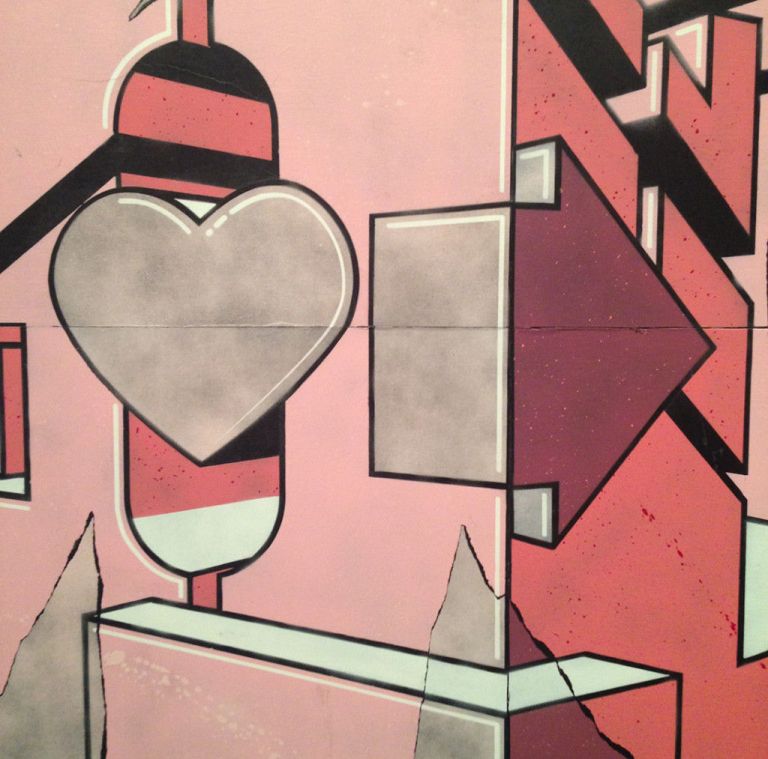
Street artists gather to create a travel through the evolution of graffiti and art with a new exhibition at LIU Post’s Steinberg Museum of Art on the second floor of Hillwood Commons on the Brookville campus. More than 35 artists are on display, with photos, graffiti painted directly on the walls, on white board, traditional canvas, digitally. Exhibit curator Ryan Seslow has created a museum space reminiscent of the graffiti boom of the 80’s and 90’s, and he has incorporated new technology to show it.
“We’ve gathered artists from five generations here, with the oldest being in their seventies, and youngest at 23,” said Seslow. “It’s the first time anyone has had this kind of street art in a proper museum space.”
Seslow, who is an artist and professor in LIU Post’s Art Department and a longtime street artist, has four of his own pieces in the show.
The pieces vary in terms of medium. One wall is covered by photographer Henry Chalfant, who’s known for his work in documenting graffiti, breakdance and hip-hop culture. The piece consists of small cutouts of subway cars from the 80s and 90s, covered in different motifs.
“He’s got over 800 of them, and that wasn’t even all of them,” said Seslow.
The new exhibition incorporates technology in a way that includes the viewer with the artists.
“We have a map of where all the artists’ works are shown in the space. But it also includes the various artists’ Instagram-tags, so you can snap a photo of the artist’s piece, tag him and ask him a question.” Seslow said. “It removes this hierarchy of who’s better, and removes some distance between the audience and artists.”
This is contrary to the traditional exhibit space, “where the artist is either dead, or impossible to reach,” he added.
There’s no intentional theme- other than street art and graffiti- in the show.
“The subject of both Graffiti and Street Art are being expanded in this show. I am interested in seeing how the works would come together on a technical and stylistic front. Can the digital works hold up with and compliment the murals? Can the framed photos compliment the 3 dimensional works?” Seslow said. “The viewer plays a big role in how they will experience the works, both physically and digitally. The show has a growing web site that functions as an artist in the show” at https://concretetodata.com.
LIU Post art students are also involved in this exhibition, through Professor Winn Rea’s class, where they are learning various molding techniques. They have molded pieces of technology, such as keyboards and cell phones, in concrete.
“Afterwards, we’re digging a hole for them, sort of as a time capsule,” Seslow said.
Steinberg Art Museum Director Barbara Applegate is happy with what she thinks is a brave exhibition.
“As a museum director, this project is a risk. Normally, you can look at the pictures up front, and keep it within the usual frames, but here, the artists came in and painted directly on the walls,” she said. “They came in, and I’m pretty sure at least one didn’t know what to put up there before he saw the space.”
Usually, the museum knows exactly where everything is going, exactly how it’s going to look, but this time, they had the risk of artists not showing up, and not knowing what they would make, which, for Applegate, was a new experience.
Content wise, Applegate was clueless as to what she would have in her museum the day after the artists were there. Street art is known for its social commentary and edginess, so she took another risk by leaving out the frames and constraints that others might have had.
“There are a few pieces that show the social commentary,” she said.
Seslow points out one piece, a modified version of the 80’s cartoon G.I. Joe, where the soldier is coming back from the Vietnam War. The work is a realistic version, where G.I. Joe is met with mental and physical struggle, as opposed to the glorifying, pro-war propaganda of the original. The six-minute cartoon is available online, at https://www.encryptedfills.com, a collaborative project between Seslow and artist RJ Rushmore, who’s got other pieces in the exhibition.
Despite the risk she’s taking, Applegate is very happy with the result, and has already gotten positive feedback from students and colleagues alike. While the artists were installing and painting, Applegate said, people passed by and were obviously hit by what she calls a very dynamic exhibition, full of contrasts and different mediums.
The reception, the official opening of the exhibit, will be held on Friday, Feb. 6 at 6 p.m., and is open to the public. The exhibition will run through March 21. For information about museum hours, go to www.liu.edu/museum.
This article was originally published in the Pioneer, the award-winning student newspaper of LIU Post, www.liupostpioneer.com, and is republished here by Blank Slate Media with the permission of the Pioneer.






